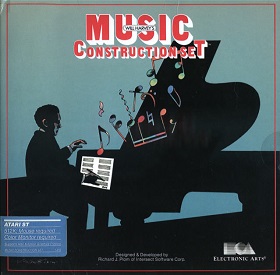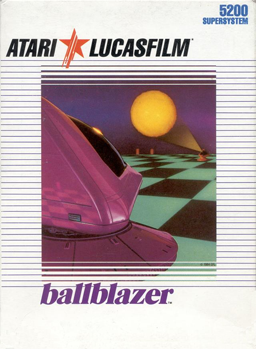Related Research Articles

Atari ST is a line of personal computers from Atari Corporation and the successor to the company's 8-bit home computers. The initial model, the Atari 520ST, had limited release in April–June 1985, and it was widely available in July. The ST was the first personal computer with a bitmapped color graphical user interface, using a version of Digital Research's GEM interface / operating system, from February 1985.

The Commodore 64, also known as the C64, is an 8-bit home computer introduced in January 1982 by Commodore International. It has been listed in the Guinness World Records as the highest-selling single computer model of all time, with independent estimates placing the number sold between 12.5 and 17 million units. Volume production started in early 1982, marketing in August for US$595. Preceded by the VIC-20 and Commodore PET, the C64 took its name from its 64 kilobytes(65,536 bytes) of RAM. With support for multicolor sprites and a custom chip for waveform generation, the C64 could create superior visuals and audio compared to systems without such custom hardware.
A disk operating system (DOS) is a computer operating system that resides on and can use a disk storage device, such as a floppy disk, hard disk drive, or optical disc. A disk operating system provides a file system for organizing, reading, and writing files on the storage disk, and a means for loading and running programs stored on that disk. Strictly speaking, this definition does not include any other functionality, so it does not apply to more complex OSes, such as Microsoft Windows, and is more appropriately used only for older generations of operating systems.

A sound card is an internal expansion card that provides input and output of audio signals to and from a computer under the control of computer programs. The term sound card is also applied to external audio interfaces used for professional audio applications.

VisiCalc is the first spreadsheet computer program for personal computers, originally released for Apple II by VisiCorp on October 17, 1979. It is considered the killer application for the Apple II, turning the microcomputer from a hobby for computer enthusiasts into a serious business tool, and then prompting IBM to introduce the IBM PC two years later. More than 700,000 copies were sold in six years, and up to 1 million copies over its history.
Microsoft BASIC is the foundation software product of the Microsoft company and evolved into a line of BASIC interpreters and compiler(s) adapted for many different microcomputers. It first appeared in 1975 as Altair BASIC, which was the first version of BASIC published by Microsoft as well as the first high-level programming language available for the Altair 8800 microcomputer.

The Commodore Plus/4 is a home computer released by Commodore International in 1984. The "Plus/4" name refers to the four-application ROM-resident office suite ; it was billed as "the productivity computer with software built in".

The Mockingboard is a sound card built by Sweet Micro Systems for the Apple II series of microcomputers. It improves on the Apple II's limited sound capabilities, as did other Apple II sound cards.

The KoalaPad is a graphics tablet, released in 1983 by US company Koala Technologies Corporation, for the Apple II, TRS-80 Color Computer, Atari 8-bit computers, Commodore 64, and IBM PC compatibles.
The Adventure Game Interpreter (AGI) is a game engine developed by Sierra On-Line. The company originally developed the engine for King's Quest (1984), an adventure game that Sierra and IBM wished to market in order to attract consumers to IBM's lower-cost home computer, the IBM PCjr.

Will Harvey's Music Construction Set (MCS) is a music composition notation program designed by Will Harvey for the Apple II and published by Electronic Arts in 1983. Harvey wrote the original Apple II version in assembly language when he was 15 and in high school. MCS was conceived as a tool to add music to his previously published game, an abstract shooter called Lancaster for the Apple II.

Ballblazer is a futuristic sports game created by Lucasfilm Games and published in 1985 by Epyx. Along with Rescue on Fractalus!, it was one of the initial pair of releases from Lucasfilm Games, Ballblazer was developed and first published for the Atari 8-bit computers. The principal creator and programmer was David Levine. The game was called Ballblaster during development; some pirated versions bear this name.
Bank Street Writer is a word processor for the Apple II, Atari 8-bit computers, Commodore 64, MSX, Mac, IBM PC, and IBM PCjr computers. It was designed in 1981 by a team of educators at the Bank Street College of Education in New York City, software developer Franklin E. Smith, and programmers at Intentional Educations in Watertown, Massachusetts. The software was sold in two versions: one for elementary school students published by Scholastic and a general version from Broderbund.
In computer architecture, shared graphics memory refers to a design where the graphics chip does not have its own dedicated memory, and instead shares the main system RAM with the CPU and other components.
The Amiga is a family of home computers that were designed and sold by the Amiga Corporation from 1985 to 1994.

Indiana Jones and the Temple of Doom is an action video game developed and published by Atari Games and released in arcades in 1985. It is based on the 1984 film of the same name, the second film in the Indiana Jones franchise. It is the first Atari System 1 arcade game to include digitized speech, including voice clips of Harrison Ford as Indiana Jones and Amrish Puri as Mola Ram, as well as John Williams's music from the film.

The history of the personal computer as a mass-market consumer electronic device began with the microcomputer revolution of the 1970s. A personal computer is one intended for interactive individual use, as opposed to a mainframe computer where the end user's requests are filtered through operating staff, or a time-sharing system in which one large processor is shared by many individuals. After the development of the microprocessor, individual personal computers were low enough in cost that they eventually became affordable consumer goods. Early personal computers – generally called microcomputers – were sold often in electronic kit form and in limited numbers, and were of interest mostly to hobbyists and technicians.

Home computers were a class of microcomputers that entered the market in 1977 and became common during the 1980s. They were marketed to consumers as affordable and accessible computers that, for the first time, were intended for the use of a single, non-technical user. These computers were a distinct market segment that typically cost much less than business, scientific, or engineering-oriented computers of the time, such as those running CP/M or the IBM PC, and were generally less powerful in terms of memory and expandability. However, a home computer often had better graphics and sound than contemporary business computers. Their most common uses were word processing, playing video games, and programming.
Throughout its lengthy, multi-model lifespan, the Apple II series computers lacked any serious built-in sound capabilities. At the time of its release in 1977, this did not distinguish it from its contemporaries, but by 1982, it shared the market with several sound-equipped competitors such as the Commodore 64, whose SID chip could produce sophisticated multi-timbral music and sound effects.
References
- 1 2 3 Games Exhibit Innovations By Scott Mace, InfoWorld, 9 Jul 1984, Page 37, Mindscape, of Northbrook, Illinois, showed Bank Street Musicwriter. The program developed by the Bank Street College of Education, which also developed Bank Street Writer...the program will be available in September...for Atari and Commodore 64...with Apple and IBM PC to follow...
- ↑ Music Buyer's Guide, By ANITA MALNIG, ANTIC VOL. 3, NO. 8 / DECEMBER 1984, BANK STREET MUSIC WRITER This new program lets the user explore and compose music. Four voices can be programmed to play at once and simple editing modes let the user save and print the music. $49.95. Mindscape, ... 48K-disk.
- ↑ Bank Street Music Writer 8-bit Sound & Fury, Bank Street Music Writer allows you to write, edit and play back music using the Mockingboard sound card, Apple II Sound & Music Software
- ↑ The PC Mockingboard, 2011/09/09, Oldskooler Ramblings, If you can't wait and want to hear what it sounds like right now, you can check out both a sample file that came with BSMW, or a piece of music I transcribed myself
- ↑ Bank Street Music Writer Sparks the Creativity of Buddy Composers By Jonathan Matzkin, PC Mag, 29 Nov 1988, Page 486, For years the Bank Street College of Education has lent its name and expertise to software that educates and stimulates creativity...
- ↑ Bank Street Music Writer by Glen Clancy, ISBN 9780870871139 - Biblio.com